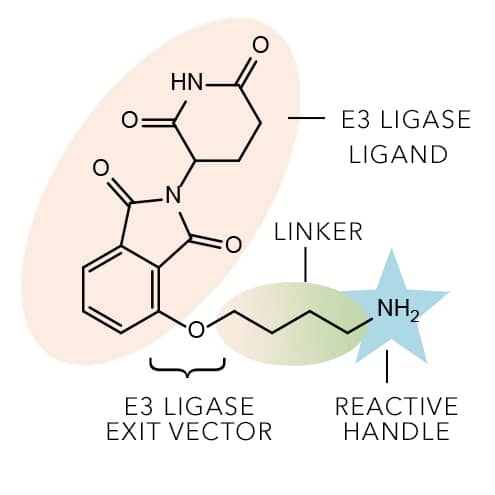The field of Targeted Protein Degradation (TPD) encompasses a growing number of modalities that achieve potent and selective knock-down of target proteins at the post-translational level. The bifunctional small molecule Degraders, including PROTAC® molecules, Degronimids, SNIPERs, LYTACs and uSMITE™ molecules, harness endogenous cellular machinery to degrade a protein of interest and are of significant interest as both research tools and potential therapeutics.
Small molecule Degraders are composed of three components: an E3 ligase ligand, a ligand that binds the target protein of interest and a linker joining them together. PROTAC® chemistry can be challenging; predicting Degrader structure-activity relationships (SAR) is not straightforward and significant medicinal chemistry effort is often required to discover a hit Degrader and progress it through hit-to-lead optimization. Additionally, the physicochemical properties of Degraders are typically distinct from small molecule inhibitors, requiring a specific set of design guidelines to maximize the chance of achieving favorable DMPK properties.
Bio-Techne provides a toolbox of products and services to support your PROTAC® Design and Synthesis.
PROTAC® Panel Builder – Degrader Discovery Just Got Easier
Are you working on developing your own small molecule Degraders? Our PROTAC® Panel Builder online tool makes PROTAC® Design and Synthesis easier. This easy-to-use online tool enables you to quickly select a bespoke collection of functionalized E3 ligase ligands plus linkers for your Degrader development project. Select your preferred:
- E3 ligase ligands plus exit vectors (targeting VHL, Cereblon or IAP)
- Linkers (PEG or alkyl chains of variable length)
- Functional groups to couple to your target ligand of interest,
and we will send you a quote for your chosen panel of Degrader building blocks. From mg to g scale, we offer unparalleled quality and customer service.
Degrader Building Blocks
Our leading range of in stock, off-the-shelf Degrader Building Blocks has been developed to support your PROTAC® design and synthesis program. We provide two types of Degrader Building Blocks, for constructing either intracellular Protein Degraders (e.g. PROTAC® Degraders), or extracellular protein Degraders (e.g. LYTAC Degraders). For intracellular proteins, our building blocks comprise E3 ubiquitin ligase ligands conjugated to PEG or alkyl linkers of variable length, with a functional handle for easy conjugation to your warhead ligand. Our expert chemists have synthesized the different permutations of E3 ligase ligand-linker-functional handle, so you don’t have to. For extracellular proteins, LYTAC building blocks consist of a ligand for a cell surface receptor conjugated to a linker with functional handle.
By providing you with the ready-made templates for conjugation to your target protein ligand we have simplified the design and chemical synthesis of new Degraders for you. Using our Degrader components, you can readily build a library of candidate small molecule Degraders for testing against your target protein of interest.
E3 Ligase Ligand Discovery
Over 600 E3 ligases are known to function in human cells, yet currently only a small number (VHL, CRBN, IAP) are commonly recruited for PROTAC® development. This is primarily due to the lack of availability of drug-like, potent small molecule ligands for these E3 ligases. Increasing the success rate of Degrader development programs against different protein targets requires small molecules targeting a broader repertoire of E3 ligases. Expanding the range of E3 ligase ligands is also desirable to achieve more selective degradation of target proteins by taking advantage of differential E3 ligase expression. Recruiting a tissue, tumor, or organ-specific E3 ligase, over a ubiquitously expressed enzyme, could reduce potential off-target effects and dose-related toxicity.
The Bio-Techne family of brands supports the discovery and development of new E3 ligase ligands for your PROTAC® development program, with a wide range of products and services including;
- Small Molecule E3 Ligase Inhibitors
- Molecular Glues
- Single Subunit E3 Ligases
- Multi-subunit E3 Ligase Complexes
- E3 Activity Kits
- Custom E3 Ligases
- Compound Libraries
Image from UbiHub reproduced with permission of the Strategic Genome Consortium.
What are LYTACs?
LYTAC or LYsosome TArgeting Chimera molecules are a new approach to Targeted Protein Degradation, which recruit and traffic extracellular target proteins to the lysosome, where they are internalized and degraded. LYTACs consist of a ligand for a cell surface receptor, such as the cation-independent mannose-6-phosphate receptor (CI-M6PR) or the asialoglycoprotein receptor (ASGPR) joined by a recruiting molecule, such as an antibody for your extracellular target protein. LYTAC Degraders form a ternary complex with the protein of interest and the receptor in a similar way to their proteasome-targeting counterparts, PROTAC molecules. This triggers internalization of the target protein via endocytosis and its subsequent lysosomal degradation.
Bio-Techne provides LYTAC Building Blocks as an advanced starting point for LYTAC development. These LYTAC Building Blocks incorporate an ASGPR ligand with linker and reactive handle ready for conjugation to a target protein ligand.
Resources for Degrader Design and Synthesis
Custom Degrader Services
Custom Degrader Services
Can’t find what you’re looking for in our catalog? We also provide custom Degraders and building blocks to support your targeted protein degradation research program.
Review: Reviewing the Toolbox for Degrader Development in Oncology
Review: Reviewing the Toolbox for Degrader Development in Oncology
The toolbox of guidelines, reagents, and technologies available to support Degrader research and development in oncology are discussed in this review.
Virtual Symposium: Targeted Protein Degradation
Virtual Symposium: Targeted Protein Degradation
Our virtual symposium brought together leading scientists in the field of targeted protein degradation to discuss their recent research and ideas around Degrader design and development.
PROTAC® is a registered trademark of Arvinas Operations, Inc., and is used under license.









